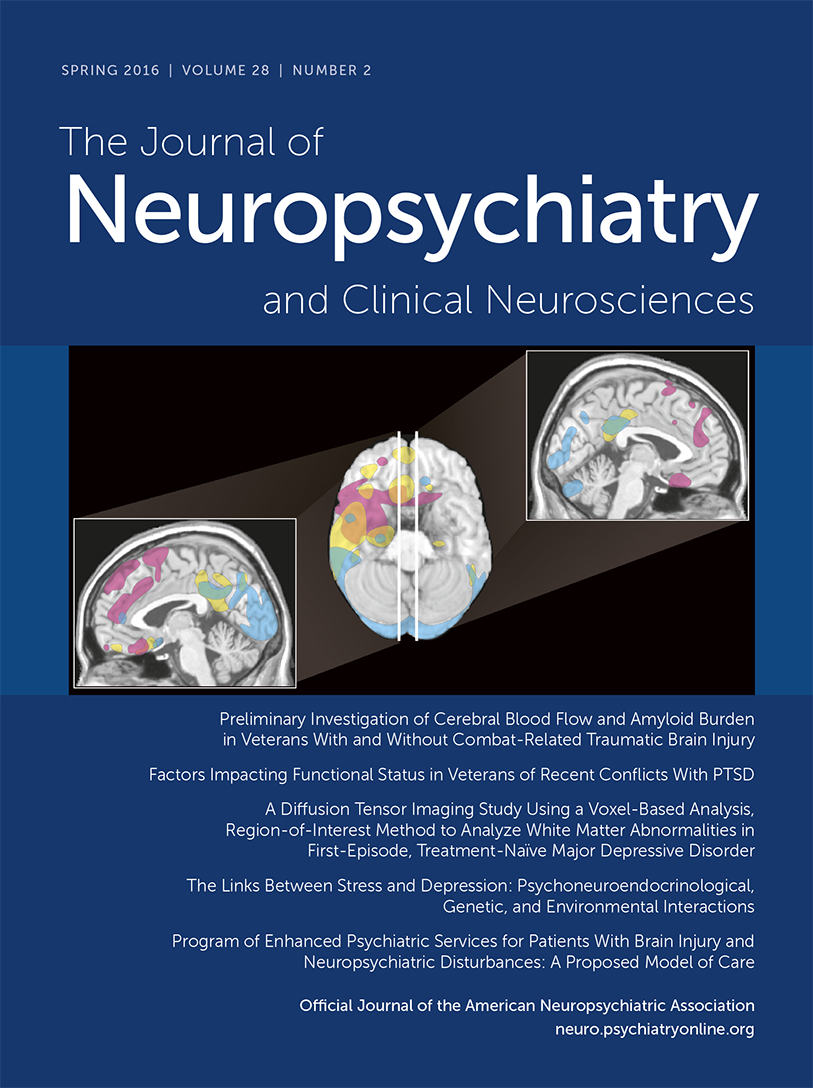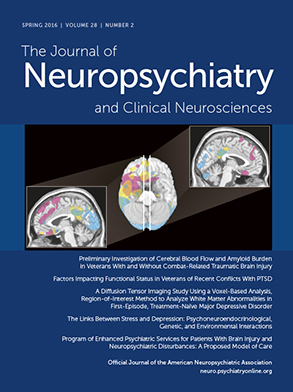To the Editor: Deep brain stimulation (DBS) is increasingly being investigated to treat a variety of disorders. The U.S. Food and Drug Administration approved DBS for essential tremor in 1997, for Parkinson's disease (PD) in 2002, for dystonia in 2003, and for obsessive-compulsive disorder in 2009.
1 Brain structures targeted by DBS in these movement disorders include the ventral intermediate nucleus of the thalamus, the globus pallidus interna, and the subthalamic nucleus.
Reported uncommon adverse effects of DBS include de novo impulse control disorder, mania, increased anger, worsening apathy, fatigue, cognitive decline, binge eating, worsening depression, de novo psychosis, and suicidality.
1–3 Depression was the most common side effect after DBS in one study (N=65) and occurred independent of target electrode placement.
4 A differential diagnostic heuristic published elsewhere may elucidate an etiology of these symptoms.
5 Emergence of manic symptoms has been associated more with ventral subthalamic DBS placement. Other associations were male gender, early-onset PD, voltage stimulations >3V, and/or unipolar stimulation mode.
6An international retrospective multicenter study of outcomes after subthalamic DBS for PD showed an elevated risk of suicide during the first year that persisted into the fourth postoperative year. Attempted suicides were associated with a younger age in general, a younger age of onset of PD, and a previous suicide attempt. Completed suicides were associated with postoperative depression.
7 In contrast, a recent large clinical trial found no increased risk of suicide for patients receiving DBS compared to medically treated patients with PD and no significant differences in suicide risk between DBS of the globus pallidus interna and the subthalamic nucleus.
8 The risk of suicide in patients receiving DBS continues to be controversial.
Studies of adverse effects attributable to DBS are limited to adult subjects. Here, we describe marked psychiatric symptoms potentially caused by DBS in an adolescent.
Case Report
We present a 14-year-old Caucasian boy with an unremarkable birth and childhood except for mild speech delay. Learning difficulties began in the third grade; by age 9.5 years, memory, attention/concentration, cognition, and behaviors began to regress. Aripiprazole, methylphenidate, and atomoxetine were tried. Within several months, the patient developed an upper extremity tremor that quickly spread to his entire body, accompanied by neck and shoulder dystonias and drooling. He rapidly became nonverbal and dependent for activities of daily living. This patient was diagnosed with a dystonic movement disorder, and symptoms improved dramatically after he was given carbidopa/levodopa.
For the next 2 years, choreiform movements and behavioral dysregulation limited use of carbidopa/levodopa. Augmentation with pramipexole, selegiline, or entacapone was only minimally effective. An exhaustive diagnostic workup was notable only for severe bilateral striatal dopamine transporter loss, consistent with juvenile-onset PD. Medication trials included fluoxetine for anxiety, quetiapine for behavioral dyscontrol and mood lability, and diazepam for muscle spasticity.
Because of intractable tremors and intolerable adverse effects of dopamimetics by age 12 years, DBS leads were implanted bilaterally in the globus pallidus interna and the ventral intermediate nucleus of the thalamus. Stimulation was set at 3.5V, and the patient concurrently received paroxetine, diazepam, trihexyphenidyl, amantadine, and carbidopa/levodopa. The last three medications were gradually tapered off because the patient’s tremors improved with DBS. Mood, anxiety, and behavioral symptoms were then manageable at home.
At 6–9 months after DBS implants, the patient’s parents noted increased mood lability, agitation, and suicidal/homicidal gestures. He exhibited peculiar behaviors such as pouring a bottle of milk over his head and over the head of a bus driver. The patient tried to strangle his father, tried to strangle himself, drank out of the dog bowl, exposed his buttocks to a drive-thru attendant, punched walls, and displayed frequent tantrums. He scribbled “kill me” on paper, and the father shared a video in which the boy hand-gestured a gun to his head. Valproic acid was added for mood dysregulation with minimal benefit, and the patient was admitted to the Child and Adolescent Psychiatry Inpatient Program at the University of Michigan.
During the first few days of hospitalization, the patient expressed fleeting suicidal gestures and was inconsistently tearful when asked about mood. Communication was difficult because he was essentially nonverbal and tremors made writing laborious. Responses were of limited complexity, and the patient responded largely by gesturing thumbs up or down for yes or no. He exhibited dramatic and rapid shifts in affect (e.g., spontaneously crying and wishing to die, followed minutes later by smiling and giving the “thumbs up”). After consultation with his neurologist, DBS voltages were gradually attenuated in outpatient care. At 2 months after discharge, the patient’s father rated symptoms before and after DBS adjustment (
Table 1). The patient continues to do well while receiving a combination of benzodiazepines, anticholinergics, paroxetine, valproic acid, trazodone, mirtazapine, and melatonin.
Discussion
There is limited literature to guide the management of comorbid psychiatric symptoms with DBS in adolescents. This case of an adolescent with debilitating tremors highlights a possible association between DBS and behavioral disinhibition, ultradian mood dysregulation, and suicidal ideation/behaviors. Similar symptoms were previously reported in adults receiving DBS for movement disorders,
3 but to our knowledge, there are no reports in children or adolescents.
Although we cannot definitively say that attenuating DBS led to the improvements in psychiatric symptoms, the timing of symptom onset after initiation of DBS (>3 months), lack of benefit of numerous psychotropic drugs, and robust resolution of symptoms with DBS attenuation support the inference. A number of factors complicate interpretation, including premorbid psychiatric symptoms, a progressive neurodegenerative process, complex polypharmacy, and the patient’s limited ability to communicate.
Although DBS can be helpful for intractable motor disorders, this case draws attention to potential negative effects on mood and behavior, possibly attributable to disruptions in adjacent limbic circuits. These are complex multidisciplinary cases in which polypharmacy complicates interpretation of symptoms and treatment decisions. Our observation suggests that consideration should be given to adjusting DBS settings in this context.

